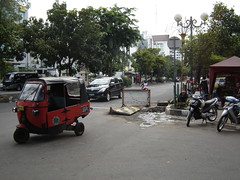
Bajajs aren’t allowed on the highways so they putter around the local roads. The fare is determined by bargaining. Here’s how it went the other day, on our first ride:
Us: How much to Sarinah’s Department Store?
Driver: 10,000 rupiah [about a dollar].
Us: Six.
Driver [with a laugh and a dismissive wave, as if we’ve proposed to pay him with a chewing gum wrapper]: No-o-o! Nine.
Us: Seven.
Driver [suddenly bored and grumpy} Okay okay, get in.
I suspect we still overpaid, but that’s what happens when you’re new to the game.
Bajajs are pretty fun until you get stuck at a red light behind another bajaj. Then the whole compartment fills with blue exhaust and you have to hold your breath and pray for the light to change.
Crossing the street is a complicated affair. Most of the intersections near our hotel don’t have pedestrian lights, so you have to guess at the traffic pattern. Then you have to do some advanced physics to calculate the different speeds of the bajajs, cars, buses and motorcycles. You don’t want to linger in anybody’s way, but you also don’t want to break into a sprint unexpectedly, since the drivers are allegedly trying to predict your speed too and avoid hitting you.
Oddly enough, the scarcity of bicycles makes it a little less frightening than

3 comments:
bajajs = mototaxis in peruvian. Small motorized vehicles used for short to medium distance transportation in Lima and other cities. Actually the Bajaj brand exists but now locals retrofit 50cc scooters (which are even cheaper). The fee however is fixed: ~10 american cents per passenger.
P.S. Have you seen any Daewoo Ticos? (the predecesor of the Rio)
I haven't seen any Daewoos. The passenger cars here generally seem very new and expensive. Definitely a status symbol - hence, all the SUVs.
One nice thing is that the taxis don't seem to honk a much as they do in Lima. They just slow down and try to catch your eye if they think you might have any inclination to hire them. The bajajs honk, but they just make a little quacking sound like a duck, so it's amusing instead of annoying.
Awesome blog! I'm reading, and enjoying your Jakarta adventures.
I already miss your stories here at wfyi! :)
Take care -Melissa D.
Post a Comment